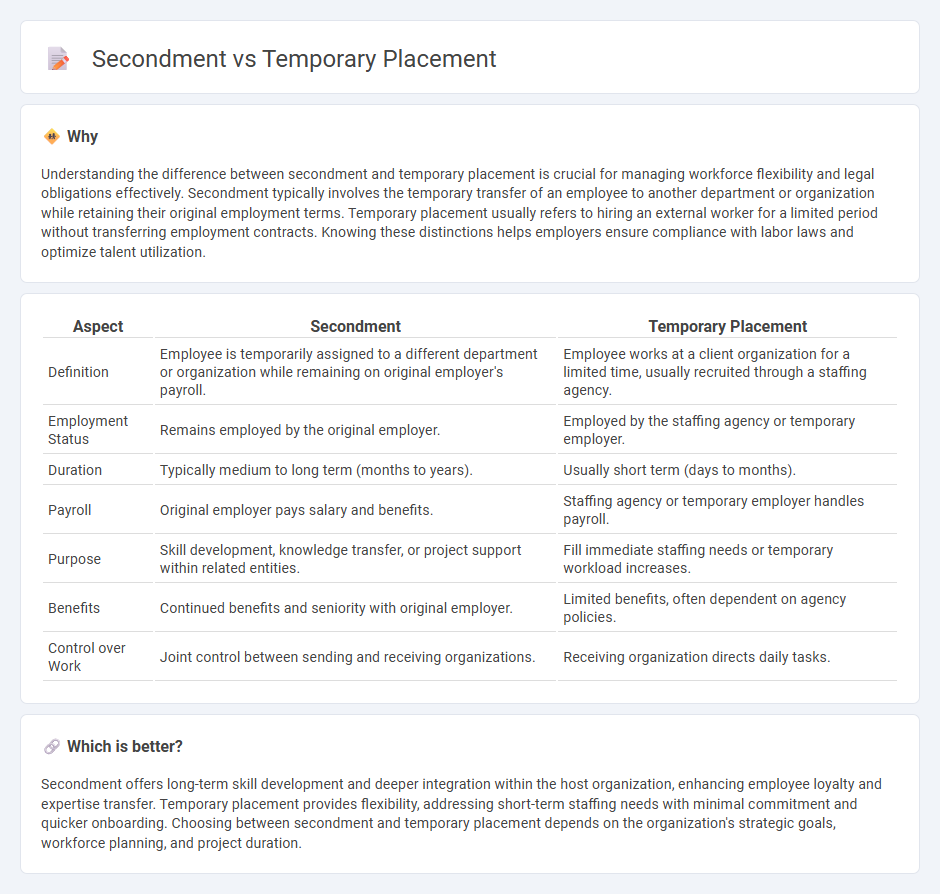
Secondment involves temporarily transferring an employee to a different department or organization to gain specialized experience while maintaining their original employment status. Temporary placement typically refers to hiring workers for a fixed period to address immediate staffing needs without long-term commitment. Explore the distinct benefits and applications of secondment and temporary placement to optimize workforce strategies.
Why it is important
Understanding the difference between secondment and temporary placement is crucial for managing workforce flexibility and legal obligations effectively. Secondment typically involves the temporary transfer of an employee to another department or organization while retaining their original employment terms. Temporary placement usually refers to hiring an external worker for a limited period without transferring employment contracts. Knowing these distinctions helps employers ensure compliance with labor laws and optimize talent utilization.
Comparison Table
| Aspect | Secondment | Temporary Placement |
|---|---|---|
| Definition | Employee is temporarily assigned to a different department or organization while remaining on original employer's payroll. | Employee works at a client organization for a limited time, usually recruited through a staffing agency. |
| Employment Status | Remains employed by the original employer. | Employed by the staffing agency or temporary employer. |
| Duration | Typically medium to long term (months to years). | Usually short term (days to months). |
| Payroll | Original employer pays salary and benefits. | Staffing agency or temporary employer handles payroll. |
| Purpose | Skill development, knowledge transfer, or project support within related entities. | Fill immediate staffing needs or temporary workload increases. |
| Benefits | Continued benefits and seniority with original employer. | Limited benefits, often dependent on agency policies. |
| Control over Work | Joint control between sending and receiving organizations. | Receiving organization directs daily tasks. |
Which is better?
Secondment offers long-term skill development and deeper integration within the host organization, enhancing employee loyalty and expertise transfer. Temporary placement provides flexibility, addressing short-term staffing needs with minimal commitment and quicker onboarding. Choosing between secondment and temporary placement depends on the organization's strategic goals, workforce planning, and project duration.
Connection
Secondment and temporary placement both serve as strategic workforce solutions that enable organizations to address short-term skill gaps and enhance operational flexibility. Secondment involves temporarily transferring an employee to another department or organization while maintaining employment status, fostering skill development and knowledge exchange. Temporary placement recruits external talent for fixed durations, allowing businesses to react swiftly to fluctuating demands without long-term commitments.
Key Terms
Contractual Relationship
Temporary placement involves a direct contractual relationship between the employer and the worker for a fixed term, whereas a secondment entails a temporary transfer of an employee to another department or organization while maintaining the original employment contract. In secondments, the employee's rights and benefits typically remain with the original employer, differentiating it from a temporary placement where these obligations shift to the temporary employer. Discover more about how contractual nuances impact workforce flexibility and organizational strategy.
Employer of Record
Temporary placement involves hiring employees through an agency that acts as the Employer of Record (EOR), managing payroll, taxes, and compliance, while the worker performs duties at the client's site. Secondment typically assigns an employee from one company to another on a temporary basis without altering the Employer of Record status. Explore more to understand how choosing between temporary placement and secondment impacts legal responsibilities and workforce management.
Duration of Assignment
Temporary placements typically range from a few weeks to several months, providing flexibility to address short-term business needs without long-term commitments. Secondments usually last from six months to two years, allowing employees to gain specialized experience and strengthen organizational ties. Explore more details to understand how duration impacts workforce strategy effectively.
Source and External Links
Temporary Placement - Persona - Temporary placement is an employment arrangement where an employee is hired for a set period to fulfill temporary staffing needs or specific projects, often through staffing agencies, offering flexibility for both employers and employees.
Understanding Temporary Placements: How They Differ from Adoption - Temporary placement refers to a short-term caregiving arrangement for children where parental rights remain with the birth parents, differing from adoption in legal status, duration, and purpose.
SECTION 2: PLACEMENTS - Arizona Department of Child Safety - Temporary placement in child welfare involves care consistent with safety and stability standards, with processes in place for review and stabilization if placement changes are considered.
 dowidth.com
dowidth.com